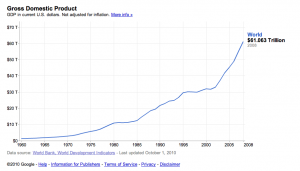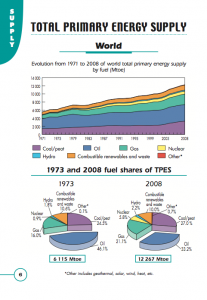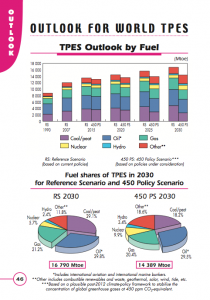Fossil Fuel and the Future of Energy Under Capitalism
I’m writing this essay partly in response to lectures by Stewart Brand and the Green Party. I’d like to speak about these lectures in relation to what we have read so far about capitalism, oil sands, arctic energy exploration and the implications for our future energy supply under a capitalist system.
Stewart Brand – Technology!
If I could summarize Stewart Brand’s lecture it would be like this: Climate change is serious and we have very little time to transition into a carbon neutral economy. The best path forward is to encourage more and faster urbanization, education and reproductive rights for women, accelerated genetic engineering of crops, bioengineering, nuclear power expansion right now with potential for fusion power to come online in the next few decades and geo engineering if necessary. In short, we need to accelerate advances in technology, economic growth and our energy infrastructure. I’ll refer back to these ideas later in reference to our readings.(1)
Green Party – Stop!
The Green Party suggested about the exact opposite stressing the Limits to Growth.(7) Their argument is that economic and population growth are the essential problems because each year our economy grows at the exponential rate of about 3% and consumes a comparative increase in material inputs like oil, water and topsoil. This consumption is an overburden to the ecosystems which support us through services like the hydrological, nutrient and carbon cycles. The only solution is to shrink our economies and population which will effect a decline in material consumption to reduce the burden on our the ecosystems.
This Limits to Growth argument rests on the premise that human activity exceeds the carrying capacity of our planet. Humans are not different than any other species which surpasses its environmental limits; If they surpass the natural limits their population will eventually crash. This should cause us concern for if our material throughput (i.e. stuff we take from the earth) and economic growth continues. In figure 1 one we see a steady exponential increase in gross domestic product (GDP), i.e. the final monetary value of combined goods and services produced, which serves as standard measure of economic growth. The graph shows a rough increase of an average of 3% increase in GDP per year. At this rate our economy will grow 3.3 times bigger over the next 40 years. In Figure 1 we see our economy was recently (2008) sitting at 61 trillion dollars. If we extrapolate that number at 3% to 2050 our economy will producing over 200 trillion dollars. The logic goes that we will also be consuming proportionally more resources, which we can’t afford to do because we already surpassed our carrying capacity decades ago. Technology is not a solution because all this new energy technology will only perpetuate business as usual economic growth, material consumption and carbon emissions. Increasing efficacy provided by technology will only decrease the intensity of material usage but not change the fact that we will still use more resources each year albeit at perhaps at a rate below 3%. The point is that it doesn’t matter how efficient our economy is if it requires more resources per unit output of GDP each year. According to this view is,the solution to stopping environmental degradation and ensuring human survival is, we don’t have a choice, we have to shrink our economies and our population by halting growth.
Mirage
My sinking feeling after hearing these lectures is that business as usual, i.e. the current formation of capitalism, and technological advance proposed by Stewart Brand is a flawed solution. It will not provide us with a solution to climate change soon enough. Not because we don’t have the technology to produce fancy new power plants, and grains, but because it will take too long and too much fossil energy to reconstruct our infrastructure for everything. New cities, buildings, vehicles, power grids and power plants will have to be rebuilt using fossil energy to transform our economy into a CO2 neutral/negative economy. Below in Figure 2 and 3 are graphs from a 2010 International Energy Agency report which shows our past and future energy supply. These graphs show that fossil fuels, oil, coal and gas have risen in use historically. Figure 3 below shows a steady increase of fossil fuel use up to 2030 with renewables making up less than half our power source at best. While certainly not set in stone, we could be emitting more carbon in the future than we are today if economic growth continues, and we have already emitted too much.
Capitalism Loves Oil
While I love the whiz bang! gadgets produced by capitalism’s wonderful capacity for innovation I feel it is not the best solution in its present form. Capitalism relies on technological change and competitive advantages in production and marketing which to date has only increasing our use on fossil energy at the very time we need to start shutting down every last fossil fuel power plant and internal combustion engine (Again see figures 2 and 3). Huber’s argument in “Energizing Historical Materialism” makes a strong case that fossil fuels are internal to the metabolism of capitalism. According to Huber, fossil energy is internal to contemporary capitalism for these reasons:
1) Fossil energy replaces human energy which decreases demand for labour and increases supply. This decreases the control of labour over the production process because there are proportionally less workers employed by each firm and by increasing the labour supply there is steady leverage against resistance because there are many more labourers to replace the resistors.
2) The ease of transportation allows concentration into cities where they can be consumed by industry and consumers.
3) Energy density and abundance have allowed increased velocities of production and time to market which in turn increases profit rates.
The problem then for any future energy source is that it will have to replicate these characteristics without a pause to sustain continued economic growth. This is then a major obstacle to stopping CO2 emissions and reducing our material consumption.
Oil Ho!
Present enthusiasm to exploit Canada’s Tar Sands and Arctic oil reserves seems natural given capitalism’s love of oil.
If we were serious about stopping CO2 emissions we would be limiting our exploitation of the Tar Sands. Yet I see no sign of a decrease in exploitation. For example Tar Sands development is a central policy of the Security and Prosperity Partnership signed by North America governments (SPP). (4) Alberta’s oil fields are the world’s largest remaining oil reserves and have attracted almost 60% of global oil investment.(4) Moreover neither Canada nor Alberta have indicated any intention to stop the total exhaustion of this resource.(4)
Similar to the Tar Sands, the Arctic is seeing vigorous investment by energy companies and energy states such as Russia. The Russians are betting on Arctic energy to fuel their future economic growth and imperial ambitions. They planted a flag beneath the North Pole on the sea bed hoping to prove that the sea floor is an extension of the Russian landmass so they can explore fossil energy deposits.(5) The Russian state owned enterprise (SOE), Gazprom, is the largest gas extractor in the world. Russia now ranks third behind Iran and Saudi Arabia for the oil and gas reserves. This would support the evidence offered by the IEA energy forecast that fossil energy is not going away anytime soon.(5)
Sounds kind of grim really. I think realistically the solutions to reduce human impacts on the earth lies somewhere in between Stewart Brand’s and ‘Limits to Growth’ arguments; We need some technological innovation and we need to seriously consider halting economic growth, at least in the developed world. Of course things may turn out quite differently than any of us can imagine. However, I don’t think that mainstream political and business leaders or society for that matter are being intellectually honest or listening to the predictions of the consequences of a business as usual future. I know there is debate over how many people the earth can support, but it would be prudent to guess on the conservative side. It’s easier to grow later than be forced to shrink after it’s too late. The friction to change our behavior is only natural because any serious reduction in energy consumption of the system is likely to the power of elites and sacrifice the high quality of life we in the developed world feel entitled to. However things may turn out, it remains to be seen how tolerant the earth’s biosphere and atmosphere are to the endless growth ideology that is capitalism and its insatiable appetite for fossil fuel.
Bibliography
(1) The ideas of Stewart Brand can be found in his new book: Whole Earth Discipline: an ecopragmatist manifesto (London: Atlantic Books, 2010)
(2) www.google.com, “global gdp”.
(3) Huber, T. “Energizing historical materialism: Fossil fuels, space and the capitalist mode of production.” Geoforum 40, (2008): 105-115
(4) Nikiforuk, Andrew. Tar Sands: Dirty Oil and the Future of a Continent (2008). p. 2
(5) Sheppard, Lola and White, Mason. “Meltdown: Thawing Geographies in the Arctic”. pp. 133-134
(6) International Energy Agency, “Key World Energy Statistics 2010”. http://www.iea.org/.
(7) Meadows, Donella. The Limits to Growth. New York: Universe Books, 1972.



1 comment
1 Stephen Purdey { 10.17.10 at 7:43 am }
Mr. Baker,
I enjoyed reading this and other excellent essays on your course blog.
You’re quite right to point out that economic growth is inherent to capitalism, but I think it’s important to recognize that the commitment to growth isn’t restricted to the capitalist mode of production. Without important exception, all regime types in the modern global polity (from dictatorships to democracies) and all socio-economic systems (whether socialist, communist or capitalist) uniformly pursue economic growth as a policy priority. Capitalism happens to be the most successful of these socio-economic systems, but the commitment to growth actually runs much deeper than a focus just on capitalism would suggest.
Consider the Cold War for example. One thinks of this conflict as an ‘arms race’ between the US and the USSR, but the two sides were also aggressively engaged in a ‘GDP-race’ because only growing economies could generate the wealth needed to support massive military production. It turned out that free-market Western capitalism out-performed Soviet state-directed growth, but this should not obscure the underlying fact that both sides endorsed and pursued economic growth, just as all states and various socio-economic systems continue to do today.
The point here is that the environmental objection to growth (specifically, its requirement for ever-increasing energy and material throughput as your essay indicates) should not be focused strictly on capitalism which is, as you say, highly efficient and innovative. Despite its good points, however, it’s clear that capitalism does need to be restrained so runaway growth is prevented. This will inevitably require political and ethical oversight and a reining in of free-market (especially neoliberal) capitalism. This proposed oversight forms an important part of the steady-state model which may be the most likely successor to the now-dominant growth model in the global polity. For those interested in learning more about the steady-state economy (SSE), and what may be required to achieve it, check out the Centre for the Advancement of the Steady-State Economy (CASSE) at the University of Maryland (steadystate.org).
Cheers, and keep us the good work!
Stephen Purdey, PhD
Department of Political Science
University of Toronto
Leave a Comment